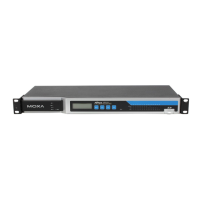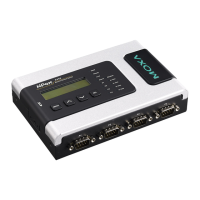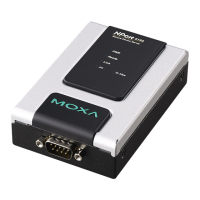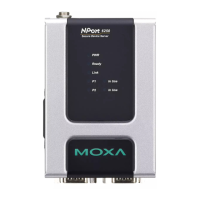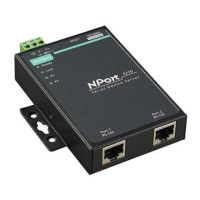NPort 6000 Series Configuring Serial Port Operation Modes
• Delimiter + 1: Data in the buffer will be transmitted after one additional byte is received following the
delimiter.
• Delimiter + 2: Data in the buffer will be transmitted after two additional bytes are received following the
delimiter.
• Strip Delimiter: Data in the buffer is first stripped of the delimiter before being transmitted.
Force transmit (default=0 ms): This parameter defines the size of a gap in serial communication the NPort
6000 will allow before packing the serial data in its internal buffer for network transmission.
As data is received through the serial port, it is stored by the NPort 6000 in its internal buffer. The NPort 6000
transmits data stored in the buffer over the TCP/IP network when the specified force transmit time is reached.
When set to 0, the force transmit time is disabled, and the NPort 6000 transmits data over the TCP/IP network
as soon as the serial data is received. At 1 to 65535, the TCP/IP protocol software will pack the serial data
received when there is a gap in serial communication that exceeds the specified force transmit time.
The optimal force transmit time depends on your application, but it must be at least larger than one character
interval within the specified baudrate. For example, let’s assume that the serial port is set to 1200 bps, 8 data
bits, 1 stop bit, and no parity. In this case, the total number of bits needed to send a character is 10 bits, and
the time required to transfer one character is (10 (bits) / 1200 (bits/s)) × 1000 (ms/s) = 8.3 ms. Therefore,
you should set the force transmit time to be larger than 8.3 ms, so in this case, it must be greater than or equal
to 10 ms.
If it is necessary to send a series of characters in the same packet, the serial device will need to send that series
of characters within the specified force transmit time, and the total length of data must be less than or equal
to the NPort 6000’s internal buffer size (1 KB per port).
Applying the above setting to NPort 6000 models with two or more serial ports, you may use the checkboxes
at the bottom of the window to apply the settings to one or more ports.
RFC2217 Mode
TCP alive check time (default=7 min): This field specifies how long the NPort 6000 will wait for a response
to keep-alive packets before closing the TCP connection. The NPort 6000 checks connection status by sending
periodic keep-alive packets. If the remote host does not respond to the packet within the time specified in this
field, the NPort 6000 will force the existing TCP connection to close. For socket and device control modes, the
NPort 6000 will listen for another TCP connection from another host after closing the connection. If TCP alive
check time is set to 0, the TCP connection will remain open even if there is no response to the keep-alive
packets.
TCP port (default=4001): This is the TCP port number assignment for the serial port on the NPort 6000. It
is the port number that the serial port uses to listen to connections and that other devices must use to contact
the serial port. To avoid conflicts with well-known TCP ports, the default is set to 4001.
